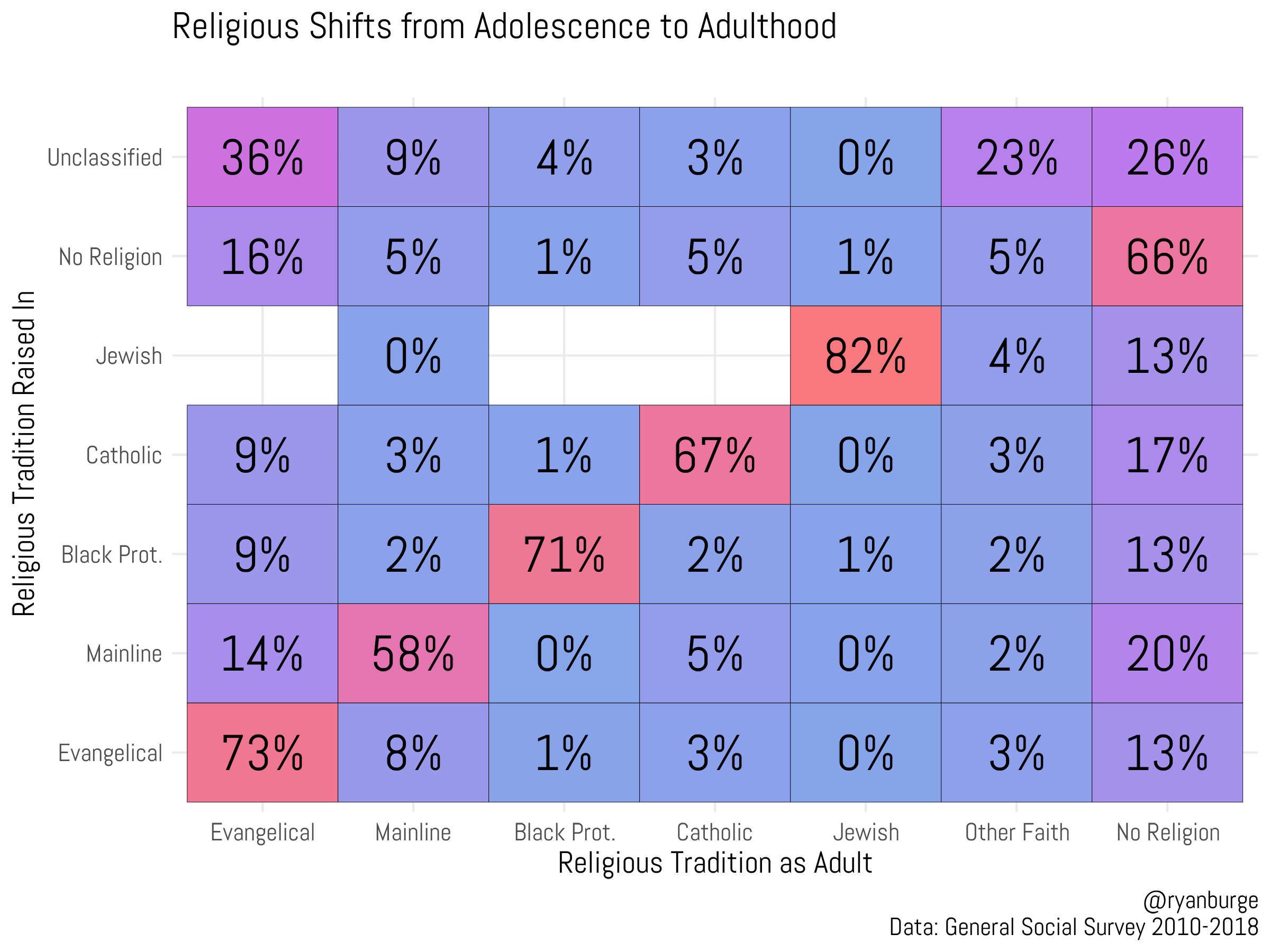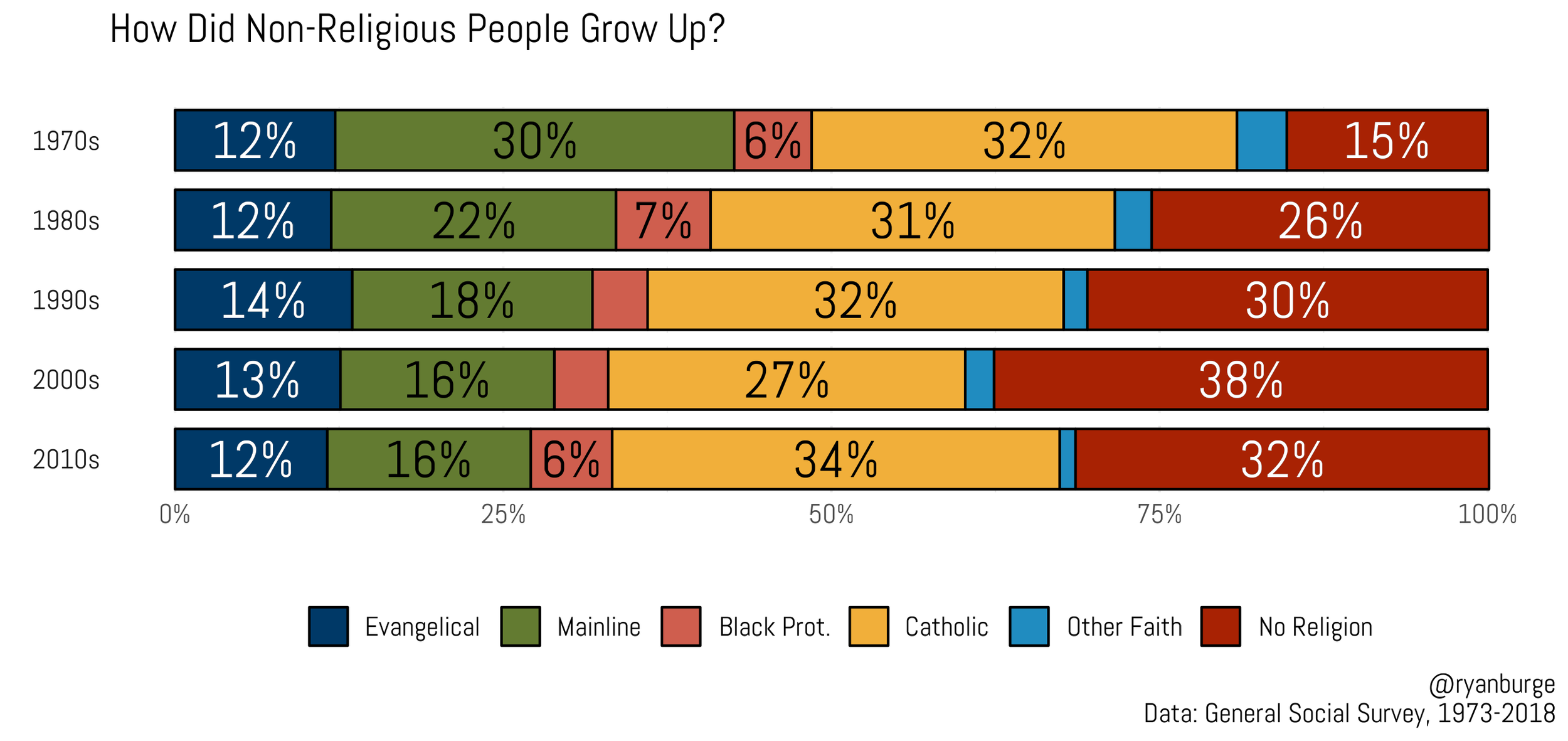Black Protestants have also seen a noticeable decline. It was 87% who stayed in the tradition. Now it’s just 71% — a 16-point decline. Catholics are in a similar boat, too. They started out pretty high at 85%; now that number is 67%, which means that about one-third of folks raised Catholic are no longer part of the church.
As previously discussed, the nones are doing better at retention, though, going from a low point of 36% in the 1970s to 66% in the last decade. That is obviously a partial explanation for why the overall share of Americans who identify with no religion has continued to rise. Their boat has become less leaky, and they have to replace fewer people who leave. For most Christian groups, there are more holes forming in the hull every year.
But so far, we’ve only discussed retention rates, not where people go when they leave their childhood religion behind. Let’s take a closer look at that now. This is how people moved around the religious landscape from childhood to adulthood. The data was collected between 2010 and 2018.

For evangelicals, 73% stick around. But the next most popular destination? Nones. Thirteen percent of those raised evangelical end up as nones as adults. That rate is actually low compared to mainline Protestants. Among those raised mainline, 14% end up becoming evangelicals and 20% switch to no religion, while a small handful convert to Catholicism.
For Catholics, the most popular destination is also no religion — 17% in this data. The only other popular destination for ex-Catholics is evangelicalism. Nearly 1 in 10 cradle Catholics are now evangelicals.
What’s interesting are the nonreligious, however. Recall that their retention rate is now about two-thirds. What about the one-third who become religious? About half of them start identifying as evangelical Christians as adults. The remainder are scattered across a lot of faith groups — a few becoming Catholics, a few switching to a non-Christian faith.
Speaking of the nones — where do they really come from? It’s basically impossible for a group to go from 5% of the population in the 1970s to 30% today without drawing from some preexisting faith traditions. I have to admit — these results are not what I expected.

First, let’s start with this clear conclusion in the data. Most nones are not born, they are made. In the last five decades there’s not been a single point when more than 40% of present nones were raised without religion. That means a significant majority of nones were converts from a theistic tradition.
In the 1970s, the mainline-to-none pipeline was strong at 30%. However, that has now slowed significantly. Just 16% of nones in the 2010s were raised mainline, about half the rate of five decades earlier. That’s likely because there are just fewer mainline Protestants to draw from today compared to 50 years ago.
Another surprising finding is just how many Americans grew up Catholic and now claim no religious affiliation. It was 32% in the 1970s, and it’s 34% today. What’s noteworthy is how stable that number has been over the last five decades. It did slowdown in the 2000s, only to return to that same one-third level in the previous decade.
I also would be remiss to ignore the fact that very few people raised in an evangelical household become nones as adults. It was 12% in the 1970s, and it was 12% in the 2010s. That’s really surprising given all the chatter we hear about evangelicals and their link to the GOP having pushed out so many people. The data just doesn’t really bear that out.
I love writing and analyzing the shifts in American religion. I think it’s a terrific way to help me wrap my head around the cultural shifts we are experiencing in the United States. But there is plenty more to do here. I hope to write a bit more about why these things are happening and what factors drive up the likelihood of someone switching religions in the future.

